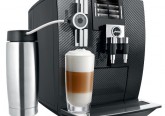Types of Home Espresso Machines
Home Espresso Machines – Operation, Benefits, and Handicaps
Stove Top (Moka Pot)
The stove-top espresso machine, also known as a moka pot, is a two-chamber device that, as the name suggests, sits on a stove burner to operate (there are also some that are self-contained electrical appliances). Water goes in the bottom chamber and coffee is held between the two halves. The steam pressure created by the boiling water in the bottom forces water up through the coffee and into the top chamber.
Benefits – Few moving parts to worry about, easy to use, inexpensive to purchase. Small and easy to transport.
Handicaps – Tends to overheat the coffee, does not make a “true” espresso since the pressure generated by the power of steam is not that great.
Steam Powered
These generally look like a home espresso machine but they have no pump. They can be identified by a large knob-like cover on top that seals the water chamber where steam is trapped. The electrical cord is only for the heating element to boil the water. Steam pressure pushes the water through the coffee.
Benefits – Doesn’t need an external source of heat, just electricity. Have few moving parts to worry about, easy to use, inexpensive to purchase.
Handicaps – Tends to overheat the coffee, does not make a “true” espresso since the pressure generated by the steam is not that great.
Manual Lever
For making “true” espresso these are the most simplest of espresso machines machines. Much like the two entries above, there is no pump. The pressure to force the water through the espresso is created by you! A lever arm is operated and either a heavy spring forces a piston down to force the water through the coffee or you pull on the lever to force the water through. Many consider this to be the truest from of espresso since you are, literally, physically involved in the entire process.

Benefits – Simplest machine design for true espresso. Many are quite visually stunning. No pump to worry about. Great potential for fine espresso production.
Handicaps – Have a steeper learning curve at first, are very sensitive to the grind of the coffee. Temperature control also must be learned with most of them as they tend to overheat when left on and unused for a while. Will be more expensive than the previously mentioned designs.
PUMP MACHINES
All the rest of these machines in this list depend on electrical pumps to force the water through the coffee. Most machines have vibratory pumps that work using a strong electromagnetic coils to move a small piston back and forth. More expensive machines have a rotary pump powered by an electric motor that is generally quieter.
Benefits – With electrical power pushing the water there is no overheating as found in steam machines. Greater consistency for most users than the previously mentioned designs. For most home machines prices range from around $250 to well over $3000. Have $10,000 to spend? You will find what you are looking for!
Handicaps – The widest range of prices and hundreds of models from dozens of manufacturers can make selection difficult. Prices start at around $250 or so, and incremental steps into the thousands for a machine can be a real temptation to move up just one more step… again and again.
Pump machines can be divided into separate categories as follows:
Semi Automatic
Most of the home espresso machines on the market today fall into this category. After all the preparatory steps (grind, dose, tamp, etc.) *1, just press a button (or flip a switch as the case may be) and the machine starts pumping water through the coffee. Turn the switch off and the machine stops.

Benefits – Less electronically complicated than the following designs and so are potentially more dependable. Makes “real” espresso.
Handicaps – Require a quality grinder and preparation accuracy is required for the best results. A good amount of “hands-on art” in the preparation.
Automatic (volumetric programmed)
These machines are much like the semi-automatic machines with the addition of a control system that can be set by the user to deliver a certain amount of water to the compacted coffee, and then automatically turn off the brew cycle. These also allow manual control of the brew cycle as well.
Benefits – Helps control consistency by delivering a predetermined amount of water for brewing then automatically turns off the brew cycle.
Handicaps – More expensive than the Semi-automatic machines. Additional electronics and sensors make them more complicated and potentially have higher repair expenses.
Super Automatic
Imagine a machine that allows you to touch a button and have it create the beverage of your choice. That is a super-automatic. These machines have built in grinders that grind on demand when a beverage is chosen. The machine dispenses the ground coffee into the brew group, tamps it, starts the brew cycle and your beverage is dispensed into your cup. Many even have the ability to froth and dispense milk based on your preferences, and some have built in cooling units that keep the milk fresh. They even tell you when it is time to empty the waste tray, when to descale, and when a cleaning cycle should be run, and much more. They do just about everything except drink your beverage.
Benefits – A good choice for those who don’t want to deal with all the preparation steps of other machines (grind, dose the coffee, tamp, etc.). Depending on the model chosen, many take up less counter space than a traditional espresso setup of machine and grinder.
Handicaps – The most complicated of all espresso machines. Can be costly to repair. Their range of adjustments can deliver a good beverage, but they are generally not as capable of delivering great espresso as an experienced user can with the previously mentioned machines.
CONCLUSION
How do you choose? A few things you can do. You first have to assess you level of commitment to the beverage. Then do some research on the various coffee forums and websites and ask questions. Finally, contact your retailer and share your needs and desires and discuss the various home espresso machine options with them.
*1 – Be aware that there are a number of machines now in this category that can use pods. These are coffee pucks which are pre-packaged, individual servings in a sort of pressed, circular tea bag sort of thing. These eliminate grinding, tamping, and other preparatory steps and do not require the user to have a grinder. While convenient, the biggest problem is that they are quite a bit more expensive per cup than using whole coffee beans.


No Comment